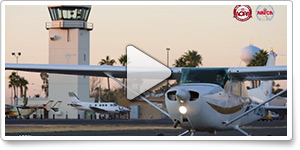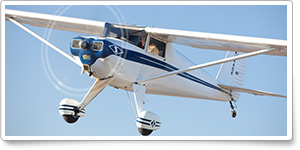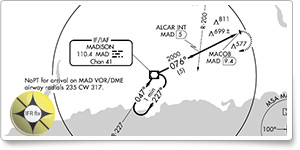Aug. 17, 2012, issue of 'AOPA ePilot: Flight Training Edition' weekly newsletter
| Comments? email [email protected], call 800/USA-AOPA | ||||||
| ||||||
| Estimated and actual |
| |||||
| [WEL] | ||||||||||||||||||||||||||||||||||||||
Training TipsEstimated and actual
That process, which a designated examiner will closely scrutinize on a checkride, starts before you leave the ground. When your pre-takeoff checks are complete and it’s time to launch, remember to jot down your takeoff time before rolling out to the runway. Make another time note when arriving at your first checkpoint. Is your actual groundspeed as was estimated based on the winds aloft forecast and your planned cruise altitude?
If it’s slower, how much additional fuel will be consumed en route? You also may need to contact flight service to update your VFR flight plan. It required you to provide an estimated time en route ( block 10). If you filed a multi-leg trip under one flight plan, discuss with your instructor whether it might be better to file them separately next time.
If you departed with full fuel, later you can compare the amount it takes to top off again with your expected fuel burn for the trip—valuable performance information for future flights in the aircraft. Don’t forget to factor in fuel consumed in taxi, takeoff, and climb phases when calculating the estimated consumption figure.
You won’t need a pen to keep track of flight conditions. Just use your eyes and ears! Altimeter settings are frequently updated on air traffic control frequencies, and are given on automated weather broadcasts at airports you pass.
Make comparing the clouds and visibility you observe to those you expected a continuing effort. Surface winds don’t always match expectations, for better or worse—another reason to monitor surface stations and seek out your destination’s weather as early as possible.
Weather that has changed significantly for the worse may be available to you through a pilot report or on a hazardous inflight weather advisory service (HIWAS) broadcast over a navaid. Monitor them, especially if your own observations have made you doubt earlier information.
Enjoy the ride, admire the view—but always be able to answer the question, “How are we doing?” Flight Training NewsNew $5,000 scholarship addedAOPA has added the Jimmie Allen Flying Club Flight Training Scholarship as the fourth award to its Flight Training Scholarship Program. The new scholarship, donated by member Sarah Wilson who pilots the 1929 Jimmie Allen Stearman Speedmail, will award $5,000 to a student pilot working toward an initial sport, recreational, or private pilot certificate. Student pilots must submit their online application and have online recommendation forms completed by Aug. 24 to be considered for one of the scholarships. Winners will be announced at AOPA Aviation Summit, Oct. 11 through 13. Learn more about eligibility and the application process online. Vision of Flight program lets youths soarHave you ever dreamed of flying? That's the question Orlando, Fla., businessman Michael McKenzie is asking youngsters ages 14 to 17 in his metro area. McKenzie asks the question in a big way, calling on history, the future, and the power of awakened aspirations to give his young target audience a new sense of direction and belonging. Read more >> Resuming the journey: Alaska mountain flyingAfter training for months to get current so that she could fly in Alaska, AOPA staff member Kathy Dondzila got to fly through the mountain passes of the Brooks Range using pilotage as her primary navigation tool. In this installment, a 15,000-hour bush pilot shows her how to maneuver in an area where the weather is often VFR below the mountain peaks—but not above. Read more >> Shine light on stellar flight training providerThink you had the best flight instructor or flight school experience? Are you training with an instructor you admire now? Nominate the school or instructor you believe embodies the best in flight training for the AOPA Flight Training Excellence Awards. A school or instructor that wins an award will exemplify what it means to be a great flight training provider, as defined by the criteria identified in AOPA’s extensive research. The nomination deadline is Aug. 24, and the awards will be given at AOPA Aviation Summit in Palm Springs, Calif., in October. Nominate someone today. Mich. community college to partner with area flight schoolJackson Community College in Michigan has signed an agreement with a flight school to take over the flight training portion of its aviation program. Solo Aviation Inc. of Ann Arbor will provide flight instruction for JCC aviation program enrollees flying out of Jackson County-Reynolds Field. The agreement will enable JCC to continue to offer its aviation program, which has seen declining student enrollment, according to the online publication MLive.com. Louisiana airport to get flight school backNatchitoches Regional Airport will soon have a flight school on the premises. Flight Academy of New Orleans, headquartered at Lakefront Airport, is set to open a second facility at Nachitoches in the fall. Flight Academy trains international students and hopes to attract Chinese students to its new location. The airport had been without a flight school since 2010, when Northwestern State University shuttered its facility, according to TheTownTalk.com. Training ResourcesLooking for tips to become a better pilot? We’ve got 25 of them, in no particular order. From short-field landings to new ratings, Budd Davisson’s suggestions will challenge you to fly more efficiently. Read more from the September 2001 issue of Flight Training .
Did you know that student pilots who join AOPA are three times more likely to complete their flight training? Membership includes unlimited access to aviation information by phone (800/USA-AOPA, weekdays from 8:30 a.m. to 6 p.m. Eastern time) or from Flight Training Online or AOPA Online. If you’re not already a member, join today and get the pilot’s edge. Login information is available online. AOPA Live This Week, Aug. 16Fly in the Alps, learn from a high-density-altitude accident, and find out how Twitter could help you avoid violating a temporary flight restriction. All this and more in AOPA Live This Week, Aug. 16. Watch AOPA Live® >> When should you ask for flight following from ATC? Career PilotAmerican Airlines pilots reject contract offerAmerican Airlines pilots rejected a contract offer on Aug. 8, USA Today reported. The Allied Pilots Association said 61 percent of its 7,500 members who cast ballots voted to reject the offer, which included pay raises and a stake in the company in exchange for more flexibility to shift flying to partner airlines. The president of the union resigned on the following day, Reuters reported. Frontier brings back nonstop Fargo-Denver serviceFrontier Airlines said Aug. 9 it will resume nonstop service from Fargo, N.D., to Denver, Colo., on Nov. 16. The airline said it last served Fargo in 2010 using 74-seat regional turboprop aircraft. The new service will be flown on 138-seat Airbus A319 aircraft. Plane SpotterLuscombe on the line Training ProductsFlight review course bundle from King SchoolsFor pilots anticipating a flight review, King Schools has created a course bundle that will save $28 over the cost of purchasing items separately. The bundle includes a VFR regulations refresher, a communications tutorial, and an airspace review. The course is presented on DVD for personal computer, or you may purchase an online version. Each is $119. Order online or call 800/854-1001.
Note: Products listed have not been evaluated by ePilot editors unless otherwise noted. AOPA assumes no responsibility for products or services listed or for claims or actions by manufacturers or vendors. Member BenefitsAOPA customer service impresses memberAOPA member Alberto Guerrero purchased non-owned insurance from AOPA along with the instructions to sign the policy form and return it to AOPA within 15 days. Guerrero said, “I screwed up and forgot to do that, and I was afraid my flying club would restrict my ability to fly—a fate worse than death.” Read more >> Aircraft re-registration: What a pilot needs to knowFor years, many of us have used the memory aid “ARROW” to remember the documents required on an aircraft. The first “R” pertains to the aircraft registration certificate. FAR 91.203 tells us we may not “operate a civil aircraft” unless it has within it an “effective U.S. registration certificate issued to its owner.” For years it has been an easy task to check for the registration certificate onboard the aircraft. We find it, make sure the N number matches the aircraft, and check that the owner and address are current. Read more >> BlogsWho are your aviation heroes?This week in the Flight Training blog, Technical Editor Jill W. Tallman wants to know which aviation figure provides you with inspiration and motivation to continue your flight training. Solo maneuvers in the Cessna 172Soloing is great, but solo flight to practice maneuvers is even better! Student pilot Blaine Transue describes a recent flight in which he put his pilot-in-command skills to work, from planning to executing a great practice session, in the Let’s Go Flying blog. AOPA Career OpportunitiesEver dream of turning your passion for aviation into a career? We’re looking for a major gifts officer, accounts payable technician, administrative coordinator, director of new market development, aviation technical generalist, and Web graphic designer. To learn more about other AOPA career opportunities, visit AOPA Online. Community
AVIATION EVENTS & WEATHER
| ||||||||||||||||||||||||||||||||||||||




 Keeping a pen or pencil—and a couple of spares—within easy reach when you launch on a cross-country flight isn’t just a good idea for writing down assigned frequencies and altitudes. It is also an important part of a high-priority piloting chore: monitoring whether your flight’s actual progress and performance match your preflight estimates.
Keeping a pen or pencil—and a couple of spares—within easy reach when you launch on a cross-country flight isn’t just a good idea for writing down assigned frequencies and altitudes. It is also an important part of a high-priority piloting chore: monitoring whether your flight’s actual progress and performance match your preflight estimates.





